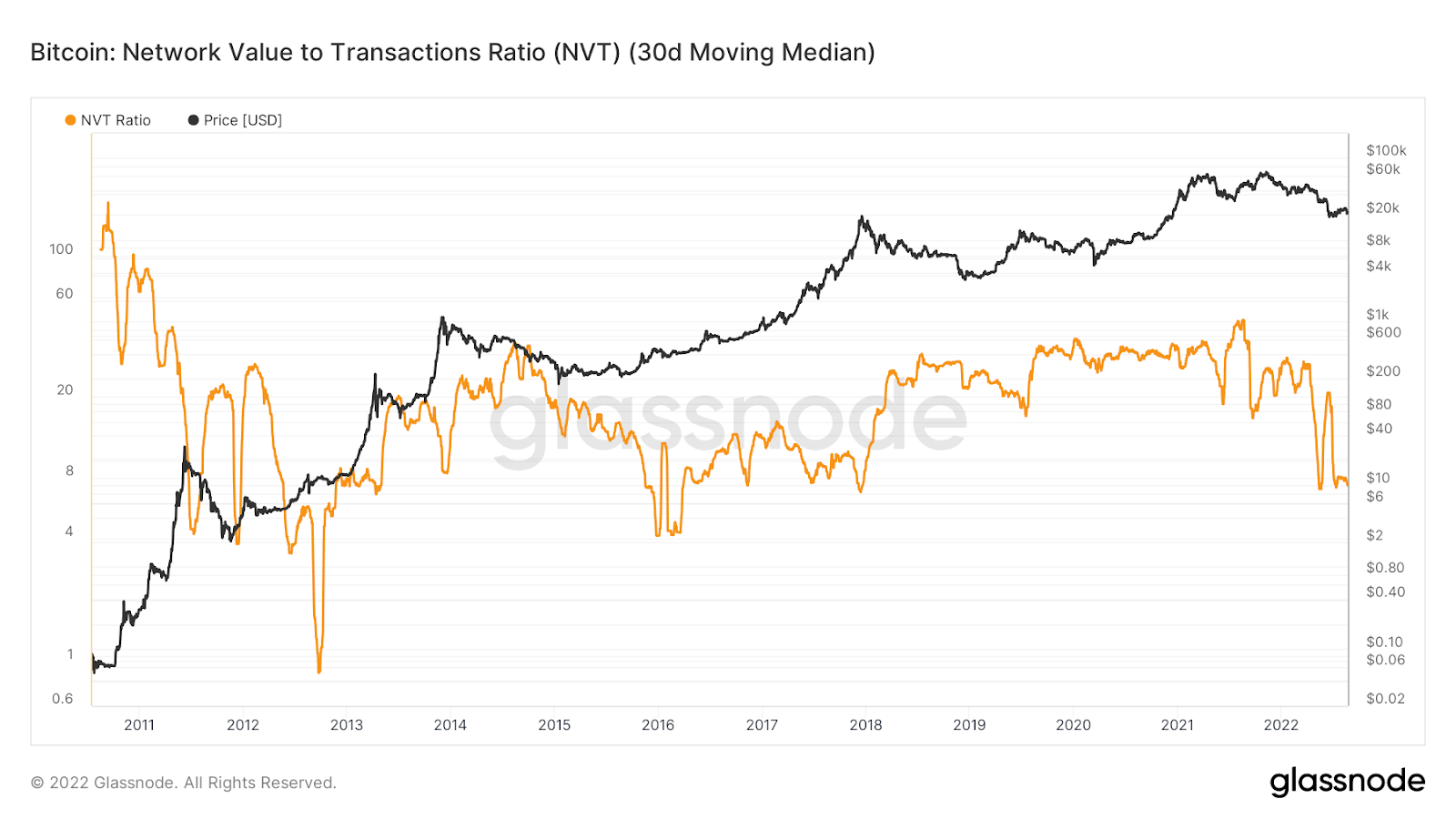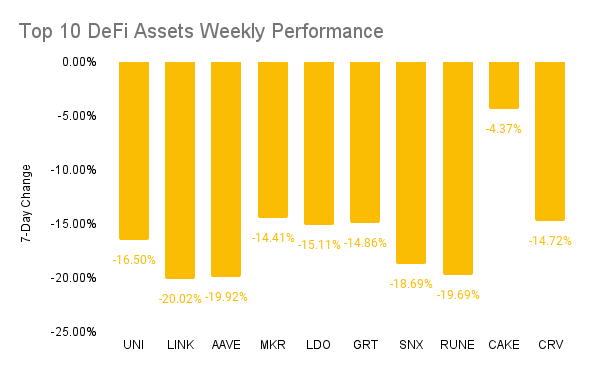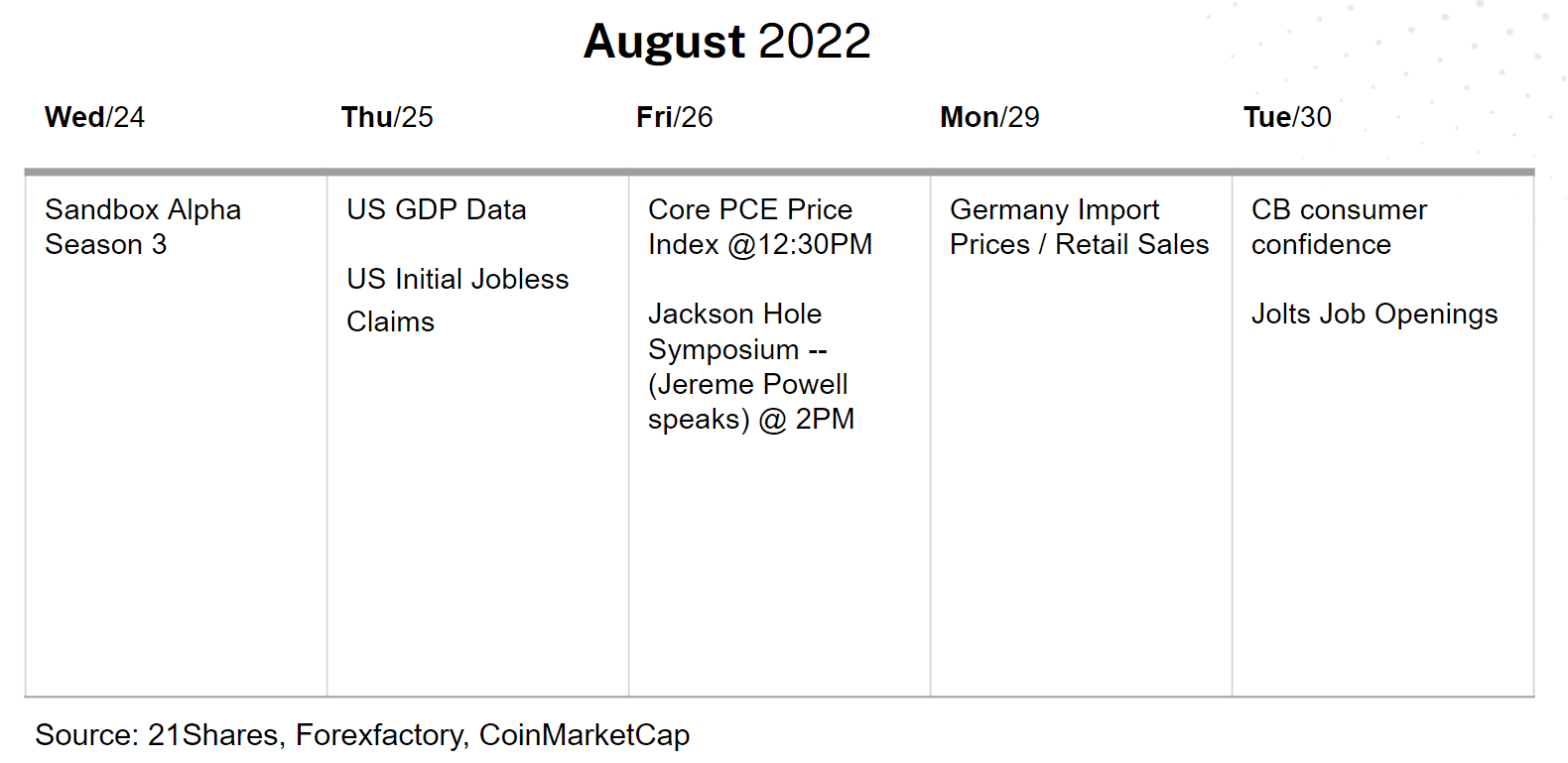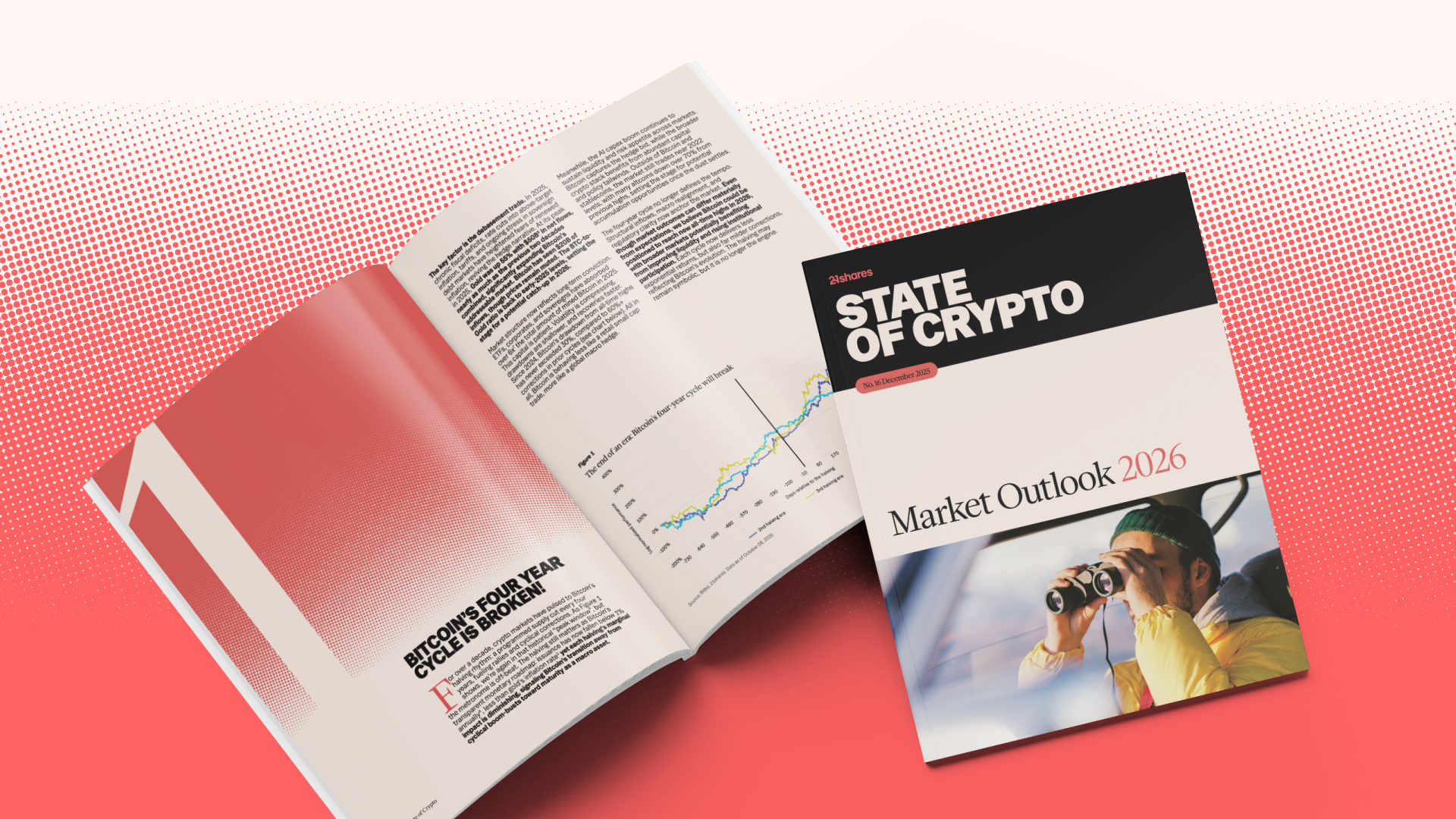Biggest ETH Mining Pool to Pull Plug on PoW Forks, NFTs in Collateral Face Potential Liquidations, and More!
.webp)


This Week in Crypto
Last week saw a downtrend in returns and TVL of most assets and protocols in major crypto categories. Over the past seven days, Bitcoin and Ethereum have declined in price by 12.6% and 18.9% respectively. The top 3 cryptoassets within these categories are Binance Coin, Polygon, and Maker, who are down by 7.4%, 21.5%, and 20.8%. However, Polygon was the only asset to have a slight increase in its assets under management, with a 0.24% increase.
Figure 1: 7-Day Price and TVL Developments of Cryptoassets in Major Sectors

Source: 21Shares, Coingecko, DeFi Llama
Key takeaways
- Millions in long liquidation may be the main contributor to a market correction
- Ethermine, the largest ETH mining pool, will not support PoW forks.
- Blue chip protocols continue siding exclusively with ETHPOS
- Hundreds of NFTs face potential liquidations on BendDAO
Spot and Derivatives Markets
Figure 2: Total Liquidations of Long and Short Positions

Source: CoinGlass
The general downtrend of the crypto market may have been escalated by a liquidation spree that happened on Friday. According to data gathered by Coinglass, over 157K traders got liquidated on Friday, resulting in total liquidations of over $600M; Bitcoin traders lost over $239M, while Ethereum lost over $224M. With around $562M worth of long positions and $79M in shorts, this marks the biggest liquidation of long positions on futures since June 13, a few days before Bitcoin’s price fell below $20K.
On-chain Indicators
Figure 3: NVT Ratio of Bitcoin (2011-2022)

Source: Glassnode
With traders failing to meet margin requirements leading to enormous liquidations, one on-chain indicator that can help track the realized valuation levels of an asset is the Net Value to Transactions Ratio (NVT), analogous to the price to earnings for stocks. As shown in Figure 3, an NVT ratio as high as 100 indicates that the price of Bitcoin is overvalued, whereas downtrends like the one seen on July 24 indicate that investors are buying Bitcoin at a discount. Back in December 2018 when Bitcoin’s price fell to $3K, the NVT ratio fluctuated between 13 and 33. Compared to its current NVT ratio resting at 4.5 as of Monday, Bitcoin appears to be undervalued.
Figure 4: NVT Ratio of Ethereum (2011-2022)

Source: Glassnode
When Ethereum’s price fell to $85 on December 16, 2018, the NVT ratio was 58.57. Compared to its current NVT ratio resting at 102.76 as of Monday, Ethereum may seem to be overvalued compared to historical levels.
Macro and Regulations
The aftermath of the Tornado Cash crackdown has led to a tightening grip on financial institutions interacting with crypto.
EU regulators have proposed amendments to a bill regulating financial services to limit European banks’ exposure to what the bill classifies as class 2 cryptoassets; which include Bitcoin and other assets that aren’t stablecoins. The amendments stipulated that the total exposure of any European bank to class 2 cryptoassets must not be higher than 1% of the institution’s Tier 1 capital at all times. In effect, Bitcoin and other assets within the classification will not be eligible for lending.
In the US, the Federal Reserve said in a supervisory letter on Tuesday that banks under its supervision should notify them before engaging in any crypto activity.
A proposed bill may give UK regulators more power over payments-focused cryptoassets like stablecoins. However, it remains unclear what exactly this bill will entail; the House of Parliament is scheduled to hold the bill’s first debate for the first time in September.
Crypto exchanges and companies around the world have been experiencing continued regulatory clampdowns. This is what happened last week:
- KuCoin and 15 others are under investigation in South Korea.
- The Federal Deposit Insurance Corporation (FDIC) sent cease-and-desist letters to FTX US and four others on allegations of false statements implying that certain products are FDIC-insured while they’re not.
However, there seems to be light in the middle of the bear market. Coin Center announced it would approach the OFAC to defend Tornado Cash and challenge sanctions.
A Federal Reserve governor seems to have pushed aside the idea of a central bank digital currency (CBDC) in favor of FedNow, a digital financial service that is said to solve the problems a CBDC was meant to solve. In the meantime, Colombia is exploring CBDCs to combat tax evasion.
Crypto Infrastructure
Exchanges: The reverberations of the Tornado Cash ban are unprecedented and may be one of the triggers of the recent drawdowns. Coinbase’s CEO asserted that it would rather shut down its staking service for ETH, rather than censor transactions on the protocol level, to comply with a hypothetical censorship order by regulators on the Ethereum blockchain. The US exchange is slated to be the third biggest validator on Ethereum once the Merge goes live, which shows how contentious such regulatory enforcement may be on a key revenue generator for the firm. Finally, Gemini will start offering new staking services for MATIC to take advantage of the bullish narrative surrounding the sector, with plans to expand to ETH, SOL, and DOT soon.
Mining Pools: Ethermine, the largest ETH mining pool, announced it’ll deprecate support for any planned POW forks. Instead, the service provider instructed its users to consider joining other POW-powered networks like Raven and Ethereum Classic if they want to continue in the mining business. Since the announcement, ETC’s hash rate has climbed to ATH over the weekend. Similarly, Bittrue will join the slew of other exchanges supporting speculative activity on potential forks as they’re scheduled to release an ETHPOW token ahead of the merge.
Ethereum Competitors: The wider verse of L1s feels the BUIDL mode as first, Near protocol released testnet phase 1 of sharding, with a mainnet tentative date set for next month. The Algorand foundation also introduced a new Quantum Proof algorithm dubbed Falcon that will be used to improve the state privacy of blockchains as well as provide quantum-resistant signatures. Solana is also headed for a performance boost as Jump Crypto is building a lighter validator client that will improve the network’s decentralization and stability, addressing one of the network’s fundamental weaknesses. Finally, Starkware launched its recursive proving system that will decrease gas costs via bundling up to 10-fold the amount of TXs processed on the main ETH chain. The improvements are following suit of Arbitrum and Optimism’s recent upgrades on enhancing the scalability and efficiency of their L2 networks, which should ameliorate the prospects for the ETH ecosystem to reach new heights later in the year.
Decentralized Finance
Figure 5: Top 10 DeFi Assets Weekly Performance

Source: 21Shares, Coingecko
Tornado Cash & The Merge: The fallout from the Tornado Cash ban continues as Uniswap publicly shared details around how it blocked 253 accounts of sanction-linked addresses and ones associated with illicit activities. On the other end of anticipating the Merge, Aave is taking cues from the biggest stablecoin issuers as it is now pushing a new governance proposal to exclusively commit to the ETHPOS network and refute any potential forks. These announcements by the vertical’s blue chips are yet again emphasizing that POW forks will be a highly speculative play without any real footing as DeFi’s most significant service providers continue to disprove the potential bifurcated chains.
Stablecoins: To regain some of its lost market share to Circle, Tether hired a top 5 accounting firm, BDO, to handle its reserve attestation, with plans to publish monthly transparency reports under this new partnership. The latest disclosing showed Tether owning $30B in treasuries. Meanwhile, Acala - Polkadot DeFi hub, managed to retrieve $2.97B worth of aUSD from last week’s hack. In other news, several bluechip DeFi protocols are starving towards amending their business models. Uniswap’s contentious Governance proposal, that we covered last week, is now underway. Sushi is also contemplating the Meiji Restoration proposal to overhaul its revenue model, its voting process, and its governing DAO.
Scalable DeFi: In an endorsement of the L2 vertical, Lido revealed its intent and updated its roadmap to expanding support for its stETH across Optimism and Arbitrum. The excitement for L2 isn’t only limited to the liquid-staking dApp, as YearnFinance, Homora, and IronBank all asserted they will be joining the Optimism network, while Redacted will be unveiling its HiddenHand bribing system on the L2. Alternatively, Solend, the biggest lender on Solana, introduced permissionless pools for any combination of tokens. Although the feature promotes capital efficiency across the network, it brings in a lot more risk with unvetted smart contracts unlike the protocols whitelisted pools. Finally, Copper, the renowned custodian, has built a native integration with the Solana network to provide its institutional clients with secured access to the network’s DeFi ecosystem via CopperConnect’s Multi-Party Computation (MPC) technology.
NFTs and Metaverse
What took crypto Twitter by storm near the end of the past week was the insolvency crisis that hit Ethereum-based NFT lending protocol BendDAO, whose reserves fell briefly below 1 ETH on Monday. How does the protocol work? BendDAO allows its users to deposit their NFTs as collateral to borrow ETH. NFT depositors can borrow up to 40% of that collection’s floor price in ETH.
Figure 6: Hourly Bend Supply and Debt

Source: 21Shares, Dune Analytics
According to BendDAO’s homepage, the “NFTfi” currently offers 87.06% APR on ETH deposits, 81.82% paid in ETH, and 5.24% paid in its BEND token. The yield is generated from NFT holders who pay interest on ETH borrowed against their NFTs; the interest rate on these ETH loans sat at 93.96% on Monday. At the time of writing, the interest rate slumped to -101.44%. Borrowers were disincentivized to pay back their loans, creating bad debt and, in turn, the liquidity crisis. The protocol’s co-founder reassured BendDAO’s community on Discord, bringing bad memories of TerraForm Labs’ sinking ship back in May. On Monday, the protocol proposed some short-term improvements:
- Adjust the liquidation threshold to 70%.
- Adjust auction period for 4 hours.
- Remove the first bid limitation of 95% of the floor price
- Adjust Interest Interest Base Rate to 20%
- Create a contingency plan to tackle bad debt.
The long-term improvements include supporting offers for collateral in BendDAO, reaching out to exchanges to list collateral, as well as supporting downpayment for auctions. As of writing, the community voted 97% in favor of the proposal. The underlying technology that makes NFTs as unique and non-fungible as they are creates numerous opportunities and use cases; being a financial instrument for borrowing still remains to be questionable given the nature of this asset class.
Next Week's Calendar

The two distinctive events of this week will be led by the release of the US GDP data on Thursday. The intelligence should denote the damage done to the US economy as a result of inflation. What’s more critical is the Core PCE price index, which is FED’s favorite metric in understanding whether inflation has truly peaked or not, and which will be released on Friday.
Disclaimer
The information provided does not constitute a prospectus or other offering material and does not contain or constitute an offer to sell or a solicitation of any offer to buy securities in any jurisdiction. Some of the information published herein may contain forward-looking statements. Readers are cautioned that any such forward-looking statements are not guarantees of future performance and involve risks and uncertainties and that actual results may differ materially from those in the forward-looking statements as a result of various factors. The information contained herein may not be considered as economic, legal, tax or other advice and users are cautioned to base investment decisions or other decisions solely on the content hereof.









_logo.svg)

.svg.png)